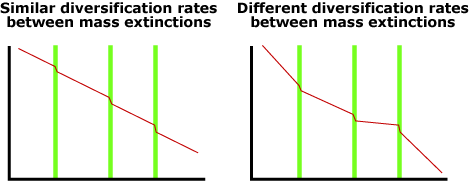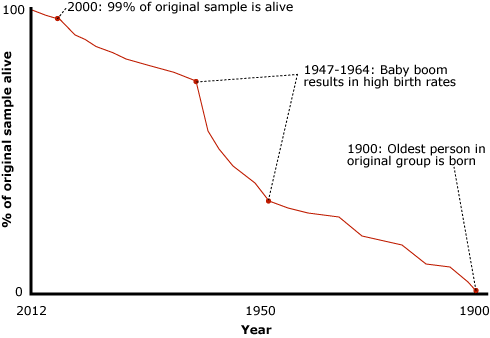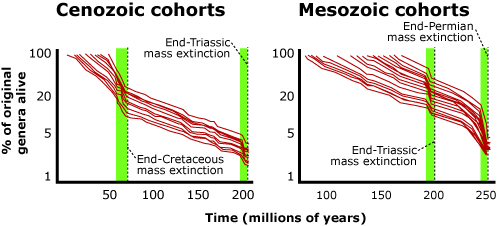
Extinction is a fact of modern life. Humanity’s relentless encroachment on the wilderness has marred the diversity of life with conspicuous gaps where the Tasmanian tiger, the Passenger Pigeon, the Ivory-billed Woodpecker, and countless others used to be. As these extinctions accumulate, the Earth inches closer and closer to its sixth mass extinction. We are all too familiar with the concept of mass extinction — a disaster strikes and sets off a chain of events that result in a massive die-off. But you may not have considered what comes next: what happens to surviving species in the wake of a massive extinction event? Recent research suggests that mass extinctions shake up life on Earth in surprising ways …
Where's the evolution?
Mass extinctions, like the one that killed the non-bird dinosaurs, leave behind a host of empty niches — unoccupied ecological real estate. Species with a “good enough” set of traits can take advantage of these resources — so, for example, the extinction of one species of leaf-litter-dwelling scavenger could allow some other species to take advantage of lucrative scavenging opportunities in leaf-litter. Over the course of many generations, natural selection will act on these species, allowing them to take better advantage of available resources. As lineages invade different niches and become isolated from one another, they split, regenerating some of the diversity that was wiped out by the mass extinction. The upshot of all these processes is that mass extinctions tend to be followed by periods of rapid diversification and adaptive radiation. Of course, the best known example of this occurred 65 million years ago when mammals began to diversify into the niches formerly occupied by dinosaurs.
In work published this summer, Andrew Krug and David Jablonski from the University of Chicago examined these post-mass extinction periods more closely. Since they wanted to reconstruct patterns of diversification that occurred many millions of years ago, the scientists focused on marine bivalves (clams and their relatives). Though clams may not seem as charismatic as mammals and dinosaurs, bivalves have a dense fossil record and are not subject to many of the biases that plague larger terrestrial organisms, which do not fossilize as consistently, or in as many places and habitats, as hard-shelled ocean dwellers.
Instead of starting with a mass extinction and trying to figure out what happened afterwards, the researchers reversed the timescale on their analysis. They focused on groups of organisms alive at a particular point in Earth’s history and traced them backwards through time to determine when they originated. To understand how this works, examine the graph here, which starts with the people living in a hypothetical city in 2012 and follows them backwards in time. In 2000, 99% of those people were alive — i.e., only one percent of the original group of people was born between 2000 and 2012. Things continue this way until around 1964 — the end of the post-World War II baby boom. Between 1947 and 1964 — during the baby boom — a large percentage of the original group of people were born. The baby boom shows up on the graph as a line with a steep slope. We continue following people back in time to their births until we reach 1900, the birth year of the oldest person in our original group of people and the point at which 0% of our original cohort of people existed. From this example, it’s clear that changes in the birthrate can be seen as changes in the slope of the line tracking births over time. A steep slope (as seen during the baby boom or in the early part of the 20th century) indicates a high birthrate, and a gradual slope (as seen during the last part of the 20th century) indicates a relatively low birthrate.
Krug (who now teaches at the K-12 Flint Hill School in Virginia) and Jablonski used the same approach with their fossil bivalves. They focused on all the bivalve genera alive at a particular point in Earth’s history (e.g., at the dawn of the Pleistocene epoch) and followed them backwards in time to determine when each of them originated. To get a sense of broad patterns in origination rates, they repeated this process for genera alive at many different times. Here, you can see their results. Each line represents a cohort of bivalves alive at a different point in Earth’s history. Each cohort is followed backwards in time over millions of years to track when members of the cohort originated.
As you’d expect, a short burst of origination events follows each mass extinction, showing up on the graph as a sharp jog upwards (the green portions of the graph). This is consistent with the idea that surviving taxa rapidly diversify into niches left vacant after a mass extinction. Once the burst of origination is over, diversification rates return to a lower level until the next post-mass-extinction period. However, the scientists also noted something more surprising in the graphs. Each period between mass extinctions was marked by a relatively constant, but different, diversification rate. Compare the idealized graphs below to the actual data above to see this pattern. After some mass extinction recoveries (e.g., after the End-Triassic extinction recovery), the rate of diversification is relatively slow, reflected in a gradually sloping line. After other mass extinctions (e.g., the End-Permian mass extinction), the standard rate of diversification is much quicker and new species are churned out at a rapid pace, reflected in a steep slope even after the initial recovery period.
Why would we observe this unexpected result? Krug and Jablonski suspect that it has to do with which taxa are most successful in the post-mass extinction period. If the taxa that take over and fill niches in the post extinction world (e.g., the mammals after the End-Cretaceous mass extinction) happen to be taxa that speciate easily, then overall diversification rates will be high until the next mass extinction shakes things up. On the other hand, if the taxa that take over after the extinction are slow speciators, then overall diversification rates will be low. This means that mass extinctions are much more important in shaping the diversity of life on Earth than ever thought before. Not only do they spur major shifts in the make-up of our biota (and hence, provide a chance for evolutionary underdogs to diversify and come out on top), but they reset the rate at which new species arise for tens of millions of years afterwards. Mass extinctions, like the one we are currently on the brink of triggering, are not just significant, but short-term, dips in diversity. They are major diversions that change the course, and pace, of life on Earth forever after.
Primary literature:
- Krug, A. Z., and Jablonski, D. (2012). Long-term origination rates are reset only at mass extinctions. Geology. doi:10.1130/G33091.1 Read it »
News articles:
- A press release summarizing the new research from UChicagoNews
- A blog post on the topic from Philly.com
Understanding Evolution resources:
- Read this short review on extinction, and explain the difference between background extinction and mass extinction.
- Why did the researchers use bivalves as the subject of their research?
- Advanced: Describe a scenario in which using a type of organism that fossilizes inconsistently for this study could have been misleading.
- Do the data that Krug and Jablonski used to analyze origination rates show mass extinctions directly or indirectly? Explain your answer.
- In your own words, summarize the findings of Krug and Jablonski’s analyses.
- Consider the following scenario: A few seeds from the hypothetical plant species Plantus florescens are blown to an island that is nearly devoid of plant life.
- Advanced: Do you think an adaptive radiation is more likely to occur after an event in which many lineages go extinction or after an event in which only a few lineages go extinct — or would it make a difference? Explain your reasoning.
- Teach about studying extinction in the fossil record: This research profile for grades 9-16 follows scientist David Jablonski as he analyzes patterns in the fossil record to learn about the rules that helped dictate who lived and died in past mass extinctions.
- Teach about adaptive radiations: This research profile for grades 9-16 follows scientist Chelsea Specht as she pieces together the evolutionary history of tropical plants and their pollinators — and in the process, tries to figure out how to conserve endangered species.
- Teach about data interpretation in evolution: This web-based module for undergraduates leads students through an exploration of the patterns in the diversity of life across planet Earth. Students are scaffolded through the exercise as they practice data interpretation and scientific reasoning skills.
- Krug, A. Z., and Jablonski, D. (2012). Long-term origination rates are reset only at mass extinctions. Geology. doi:10.1130/G33091.1


